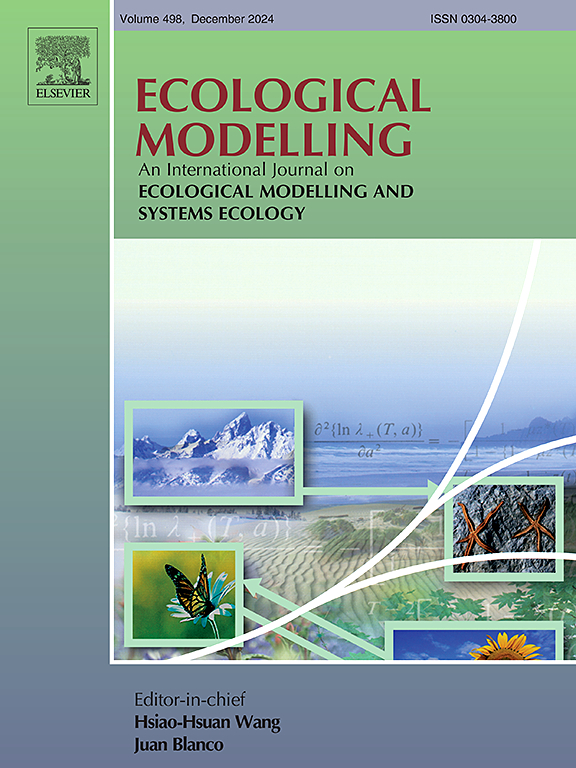Global sensitivity analysis of the harmonized Lemna model
IF 2.6
3区 环境科学与生态学
Q2 ECOLOGY
引用次数: 0
Abstract
Mechanistic effect modelling is becoming increasingly important for environmental risk assessment in the framework of pesticide authorization. For instance, the European Food Safety Authority (EFSA) has judged the model for the aquatic macrophyte test organism Lemna as “ready for use.” Nevertheless, national regulatory authorities are still hesitant to accept mechanistic effect modelling studies.
In order to increase the confidence in the Lemna model, in this study we performed a two-step global sensitivity analysis (GSA) of the harmonized model. GSA notably allows identifying and ranking the importance of i) toxicokinetic (TK) and toxicodynamic (TD) parameters, ii) physiological and ecological parameters, iii) environmental driving variables, and iv) initial conditions.
In a first step a Morris sensitivity screening was conducted to filter out non-influential input factors. In a second step, a true variance-based GSA was carried out with the Sobol method. The GSA was conducted for four different concentration levels and three different exposure regimes: constant, pulsed and realistic. Moreover, two different sets of input distributions of TKTD parameters were examined. The target variables were the effects of the pesticide on Lemna biomass and average growth rate.
Both Morris and Sobol GSA showed that for a specific substance three physiological parameters (optimum and minimum growth temperature, maximum photosynthesis rate) and the initial biomass BM0 were more important than the five TKTD parameters. Hence, for predictive applications of the model outside a laboratory context, BM0 must be chosen carefully, and uncertainty in the main physiological parameters must be reduced to a minimum.

协调Lemna模型的全局敏感性分析
机制效应建模在农药授权框架下的环境风险评估中变得越来越重要。例如,欧洲食品安全局(EFSA)已经判定水生大型植物试验生物lena的模型“可以使用”。然而,国家管理当局仍然对接受机制效应模型研究犹豫不决。为了提高Lemna模型的置信度,本研究对协调模型进行了两步全局敏感性分析(GSA)。GSA特别允许识别和排序i)毒性动力学(TK)和毒性动力学(TD)参数的重要性,ii)生理和生态参数,iii)环境驱动变量,以及iv)初始条件。在第一步莫里斯敏感性筛选进行过滤掉非影响输入因素。在第二步中,使用Sobol方法进行了真正的基于方差的GSA。GSA在四种不同的浓度水平和三种不同的暴露机制下进行:恒定、脉冲和现实。此外,还研究了两组不同的TKTD参数输入分布。目标变量为农药对Lemna生物量和平均生长率的影响。Morris和Sobol GSA均表明,对于特定物质,3个生理参数(最适和最低生长温度、最大光合速率)和初始生物量BM0比5个TKTD参数更重要。因此,对于该模型在实验室环境之外的预测应用,必须仔细选择BM0,并且必须将主要生理参数的不确定性降至最低。
本文章由计算机程序翻译,如有差异,请以英文原文为准。
求助全文
约1分钟内获得全文
求助全文
来源期刊

Ecological Modelling
环境科学-生态学
CiteScore
5.60
自引率
6.50%
发文量
259
审稿时长
69 days
期刊介绍:
The journal is concerned with the use of mathematical models and systems analysis for the description of ecological processes and for the sustainable management of resources. Human activity and well-being are dependent on and integrated with the functioning of ecosystems and the services they provide. We aim to understand these basic ecosystem functions using mathematical and conceptual modelling, systems analysis, thermodynamics, computer simulations, and ecological theory. This leads to a preference for process-based models embedded in theory with explicit causative agents as opposed to strictly statistical or correlative descriptions. These modelling methods can be applied to a wide spectrum of issues ranging from basic ecology to human ecology to socio-ecological systems. The journal welcomes research articles, short communications, review articles, letters to the editor, book reviews, and other communications. The journal also supports the activities of the [International Society of Ecological Modelling (ISEM)](http://www.isemna.org/).
 求助内容:
求助内容: 应助结果提醒方式:
应助结果提醒方式:


